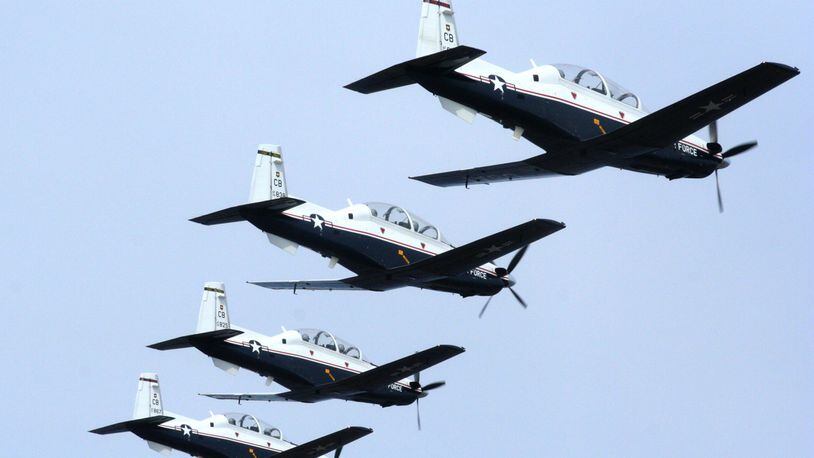The Air Force has reported 12 physiological incidents in the T-6 since March 1, following a nearly month-long grounding of the propeller-driven training planes that was lifted Feb. 27, according to the Air Force.
The service branch has a $195,000 contract with the Spotlight Labs of Sterling Heights, Mich., for a device called a SPYDR. Twenty of the devices were used in the testing.
RELATED: Wright-Patterson researchers hunt for clues in stealth fighter issue
“As we collect more and more data, we can start to see trends by what’s causing these physiological events,” said Jennifer Farrell, chief engineer of the Human Systems Office at the Agile Combat Support Center at Wright-Patterson.
“One of the things we are working with them on is how to get that threshold at the right level so the alarm is going off when they need it too but not false alarms.”
The device was implanted in a helmet ear cuff to monitor heart rate and blood oxygen levels,among other data, researchers said.
The alarm is meant notify pilots before they notice symptoms to give them enough time to get to a safe place, said 2nd Lt. Jessica Farris, program manager of the Pulse/Hypoxia Observation Gear (PHOG) team.
“We’re using it to bolster pilot confidence right now,” she said.
Researchers have not yet announced the cause of the problem, but the 711th Human Performance Wing at Wright-Patterson was investigating the on-board oxygen generating system, air samples and equipment, and other oxygen components, according to base spokesman Brian Brackens.
Nine instructor pilots have tested the device at Randolph Air Force Base, Texas. More upcoming tests were scheduled at Edwards Air Force Base, Calif., under a separate $40,000 contract.
RELATED: Massive 270,000 aeromedical device comes to Dayton
Both Air Force and Navy air crew have reported repeated physiological events in jet fighters. In the Air Force, for example, the F-35 was temporarily grounded at a base in Arizona last year while Air Force Research Laboratory researchers at Wright-Patterson’s On-Board Oxygen Generation Laboratory searched for a cause.
The Navy has reported numerous physiological incidents in the F/A-18 fighter jet, E/A-18 anti-electronic warfare jet, the T-45 Goshawk and the F-35B/C aircraft.
Navy officials were scheduled to visit Wright-Patterson this month to review Air Force research and equipment, said Lt. Col. Jeff Hamblin, deputy of Agile Combat Support human systems program office.
RELATED: Navy aviators faced Arctic-temperatures in plane mishap; Turner wants answers
U.S. Rep. Mike Turner, R-Dayton, chairman of the House Armed Services Tactical Air and Land Forces subcommittee, has held several hearings and questioned Pentagon authorities about the ongoing problem.
“We continue to be concerned by the increased rates of physiological episodes occurring in Navy and Air Force aircraft,” he said in prepared remarks this month. “We recognize the work that is being done to mitigate these events but remain concerned about the overall progress made in determining a root cause.”
FIVE QUICK READS
Need a job? More than 160 employers will be at UD Arena
Royal Air Force marks 100th in the birthplace of aviation
About the Author
